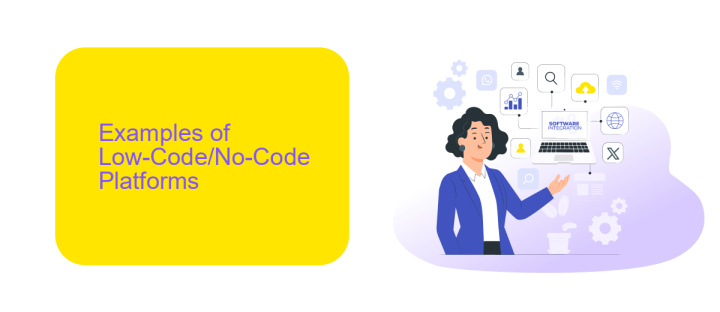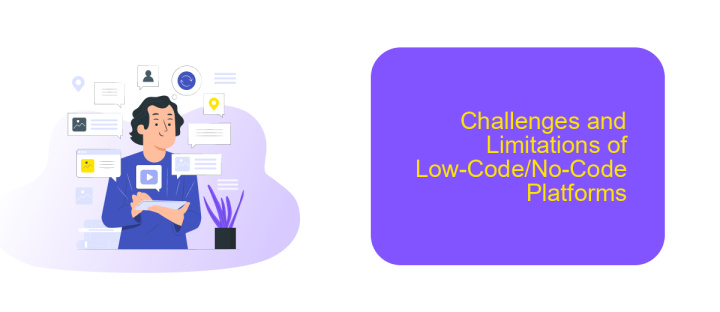Low-Code/No-Code Platforms Examples
Low-code and no-code platforms are revolutionizing the way businesses develop applications, enabling users to create software with minimal or no coding skills. These platforms empower non-developers to build functional, scalable solutions quickly and efficiently. In this article, we will explore some of the leading low-code/no-code platforms, highlighting their unique features and how they can benefit your organization.
Introduction to Low-Code/No-Code Platforms
Low-Code/No-Code platforms are revolutionizing the way businesses develop applications. These platforms allow users to create software solutions with minimal or no coding knowledge, making technology more accessible to non-developers. They are designed to accelerate the development process, reduce costs, and empower more people to contribute to digital transformation.
- Low-Code: Requires minimal coding, ideal for users with some technical knowledge.
- No-Code: Requires no coding, perfect for users with no technical background.
- Integration: Easily connects with other tools and services, like ApiX-Drive, to streamline workflows.
By leveraging Low-Code/No-Code platforms, organizations can quickly adapt to market changes and innovate faster. These platforms often come with pre-built templates and drag-and-drop interfaces, making it easier to design and deploy applications. Moreover, services like ApiX-Drive enhance these platforms by offering seamless integration capabilities, enabling users to automate processes and improve efficiency without writing a single line of code.
Examples of Low-Code/No-Code Platforms

Low-code and no-code platforms are revolutionizing the way businesses develop applications by reducing the need for extensive coding knowledge. One popular low-code platform is Microsoft Power Apps, which allows users to create custom business applications with a simple drag-and-drop interface. Another example is OutSystems, which provides robust tools for enterprise-grade app development, enabling rapid prototyping and deployment.
For those looking to integrate various services without writing code, ApiX-Drive is an excellent no-code option. It enables seamless connections between different applications and automates workflows, making it easier for businesses to synchronize data across platforms. Additionally, platforms like Bubble offer a no-code environment for building web applications, allowing users to design and launch fully functional websites without any programming skills. These platforms empower organizations to innovate quickly and efficiently, democratizing the app development process.
Benefits and Use Cases of Low-Code/No-Code Platforms

Low-Code/No-Code platforms offer numerous benefits that make them increasingly popular among businesses and developers. These platforms significantly reduce the time and cost associated with software development by allowing users to create applications without extensive coding knowledge. They also empower non-technical users to participate in the development process, fostering innovation and collaboration within teams.
- Rapid Prototyping: Quickly create and test application prototypes to validate ideas and gather feedback.
- Cost Efficiency: Reduce development costs by minimizing the need for highly specialized developers and lengthy coding processes.
- Integration Capabilities: Easily integrate with other tools and services, such as ApiX-Drive, to streamline workflows and automate processes.
- Scalability: Build scalable applications that can grow with your business needs without extensive rework.
- Enhanced Collaboration: Enable cross-functional teams to work together more effectively, leveraging diverse skills and perspectives.
Use cases for Low-Code/No-Code platforms span various industries and applications. For instance, businesses can develop customer relationship management (CRM) systems, automate routine tasks, and create custom dashboards. Educational institutions might use these platforms to build learning management systems, while healthcare providers can streamline patient management processes. Overall, Low-Code/No-Code platforms democratize application development, making it accessible to a wider range of users and driving digital transformation across sectors.
Challenges and Limitations of Low-Code/No-Code Platforms

Low-code and no-code platforms offer significant advantages, but they also come with their own set of challenges and limitations. One major issue is the potential for limited customization, which can be a significant drawback for businesses with unique requirements. These platforms often provide a range of pre-built templates and modules, but the ability to tailor these components to specific needs can be restricted.
Another challenge is the dependency on the platform provider. If the provider experiences downtime or other technical issues, it can directly impact the operations of businesses relying on their services. Additionally, there can be concerns about data security and compliance, particularly for industries that handle sensitive information.
- Limited customization options
- Dependency on platform provider
- Data security and compliance issues
- Scalability concerns
- Integration limitations
Integration with other systems can also be a hurdle. While platforms like ApiX-Drive can facilitate seamless integrations, not all low-code/no-code solutions offer such capabilities. Businesses must carefully evaluate whether the platform can meet their integration needs without requiring extensive manual intervention. Despite these limitations, low-code and no-code platforms remain a valuable tool for many organizations, particularly those looking to accelerate development cycles and reduce costs.
- Automate the work of an online store or landing
- Empower through integration
- Don't spend money on programmers and integrators
- Save time by automating routine tasks
Future of Low-Code/No-Code Platforms
The future of Low-Code/No-Code platforms looks incredibly promising, driven by the increasing demand for rapid application development and the democratization of software creation. These platforms empower non-technical users to build and deploy applications without extensive coding knowledge, significantly reducing the time and cost associated with traditional software development. As businesses continue to seek agility and innovation, Low-Code/No-Code platforms are expected to become even more integral, allowing organizations to quickly adapt to market changes and customer needs.
Moreover, the integration capabilities of Low-Code/No-Code platforms are set to expand, enabling seamless connectivity between various software systems. Tools like ApiX-Drive are at the forefront of this evolution, offering automated integration solutions that simplify the process of connecting different applications and services. By leveraging such tools, businesses can ensure smoother workflows and more efficient data management, further enhancing the usability and effectiveness of Low-Code/No-Code platforms. As technology advances, these platforms will likely incorporate more sophisticated features, including AI-driven development and advanced analytics, solidifying their role in the future of software development.
FAQ
What are Low-Code/No-Code platforms?
Who can benefit from using Low-Code/No-Code platforms?
What types of applications can be built with Low-Code/No-Code platforms?
How do Low-Code/No-Code platforms handle integrations with other systems?
Are Low-Code/No-Code platforms secure for developing business applications?
Apix-Drive is a universal tool that will quickly streamline any workflow, freeing you from routine and possible financial losses. Try ApiX-Drive in action and see how useful it is for you personally. In the meantime, when you are setting up connections between systems, think about where you are investing your free time, because now you will have much more of it.


